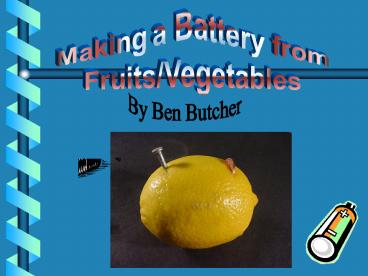Making a Battery from - PowerPoint PPT Presentation
1 / 11
Title:
Making a Battery from
Description:
100 Award-winning Science Fair Projects, by Glen Vecchione. So you have to do a Science Fair Project, by Joyce Henderson and Heather Tomasello ... – PowerPoint PPT presentation
Number of Views:216
Avg rating:3.0/5.0
Title: Making a Battery from
1
Making a Battery from Fruits/Vegetables
By Ben Butcher
2
Abstract
Abstract The purpose of this experiment is to
see if you can make a battery out of a lemon,
potato, apple, orange, and onion with the right
materials and see if any of them have enough
power to make a simple digital clock work. If you
make batteries out of these objects correctly,
then they will be able to power a clock. In this
experiment, I will take one lemon, potato, apple,
orange, and onion and, with these and other
materials, attempt to make a battery out of each
of them.
Continued
3
Abstract
(continued)
I will then test each one by connecting them to a
clock and record if each of them work or not and
by checking their voltage with a voltmeter. The
type of experiment that will be conducted will be
a research and field test experiment. I will
record the data by writing it down when I test
each battery to see if it powers the simple
digital clock.
4
Background
- For this project, I researched some sites from
the Internet and a few books. The books included - 100 Award-winning Science Fair Projects, by Glen
Vecchione - So you have to do a Science Fair Project, by
Joyce Henderson and Heather Tomasello - The web sites included
- http//pbskids.org/zoom/activities/sci/lemonbatter
y. html - http//www.funsci.com/fun3_en/electro.htm2
- http//scienceforfamilies.allinfo.about.com/featur
es/fruitcell.htm -
Continued
5
Background
(continued)
From these sources, I learned that it is possible
to make batteries out of lemons, potatoes,
apples, oranges, and onions when you make them a
certain way. This is because they, like
batteries, have some form of acid in them that
will charge a conductor and produce a small
electric current. This electric current should be
able to produce enough electricity to be about 1
volt.
6
Purpose
The purpose of this experiment is to see if you
can make a battery out of a lemon, potato, apple,
orange, and onion with the right materials and
see if any of them have enough power to power a
simple digital clock.
7
Hyothesis
If you make a battery out of a lemon, potato,
orange, apple, and onion correctly using the
right materials, then the batteries should each
have enough power to make a simple digital clock
work and will produce about one volt of energy.
8
Materials
- For this experiment, you need the following
materials - One lemon, orange, onion, potato, and apple
- Five copper metal strips
- Five zinc metal strips
- About a foot of copper wire
- A simple battery-powered electronic device like
a digital clock - Knife
- Wire-cutter
9
Methodology/Procedure
- Gather materials.
- Read over procedure.
- Form hypothesis.
- With the knife, cut two holes in each of the
fruits/vegetables about one inch apart. - Insert one copper and one zinc strip of metal in
each of these objects in the holes you made with
the knife. - With the wire cutter, cut five pieces of the
copper wire a little more than one inch long
each. - With this copper wire, connect each pair of
copper and zinc metal strips.
Continued
10
Methodology/Procedure
(continued)
8. Connect each of these objects to the simple
battery-powered electrical device to see if they
work or not. 9. Connect these objects to the
voltmeter to see how much electricity they
contain. 10. Make observations. 11. Analyze
Results. 12. Make Conclusions.
11
The End...
I hope you enjoyed the presentation.































